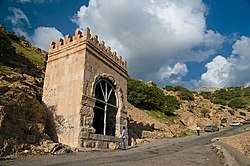Sarpol-e Zahab (Persian: سرپل ذهاب)[a] is a city in the Central District of Sarpol-e Zahab County, Kermanshah province, Iran, serving as capital of both the county and the district.[4] The town is close to Qasr-e Shirin and the Iraqi border.[5]
Sarpol-e Zahab
Persian: سرپل ذهاب | |
|---|---|
City | |
| Serpêlî Zehaw | |
 | |
| Coordinates: 34°27′32″N 45°51′41″E / 34.45889°N 45.86139°E[1] | |
| Country | Iran |
| Province | Kermanshah |
| County | Sarpol-e Zahab |
| District | Central |
| Population (2016)[2] | |
• Total | 45,481 |
| Time zone | UTC+3:30 (IRST) |
Demographics
editLanguage and ethnicity
editThe town is populated by Kurds.[6]
Population
editAt the time of the 2006 National Census, the city's population was 34,632 in 8,210 households.[7] The following census in 2011 counted 35,809 people in 9,447 households.[8] The 2016 census measured the population of the city as 45,481 people in 12,850 households.[2]
Reliefs
editThe area of Sar-e Pol-e Zahab has several more or less well preserved reliefs of the Lullubi kingdom, as well as a Parthian relief.
Lullubian reliefs
editThe most famous of these reliefs is the Anubanini rock relief. Another relief named Sar-e Pol-e Zohab I is about 200 meters away, in a style similar to the Anubanini relief, but this time with a beardless ruler.[9] The attribution to a specific ruler remains uncertain.[9] There are also other Lullubian relief in the same area of Sar-e Pol-e Zahab.[10]
-
Sar-e Pol-e Zahab, relief I[9]
-
Sar-e Pol-e Zahab, relief II: Anubanini rock relief[9]
-
Sar-e Pol-e Zahab, relief III[9]
-
Sar-e Pol-e Zahab, relief IV[9]
Parthian relief
editAnother relief is located below the Anubanini relief, lower on the cliff. This relief was created during the Parthian Empire in the name of Gotarzes, possibly Gotarzes I, but more probably the Parthian king Gotarzes II, who ruled from 39 to 51 CE and is known to have made other reliefs, such as the equestrian relief at Behistun.[11][12]
-
The second relief, below the Anubanini relief, a Parthian relief.
-
Drawing of the Parthian relief.
See also
editNotes
editFurther reading
edit- Hrouda, Barthel; Trümpelmann, Leo (1977). Sarpol-i Zohab. Iranische Denkmäler, vol. 7C. Reimer: Berlin.
References
edit- ^ OpenStreetMap contributors (13 December 2024). "Sarpol-e Zahab, Sarpol-e Zahab County" (Map). OpenStreetMap (in Persian). Retrieved 13 December 2024.
- ^ a b Census of the Islamic Republic of Iran, 1395 (2016): Kermanshah Province. amar.org.ir (Report) (in Persian). The Statistical Center of Iran. Archived from the original (Excel) on 3 April 2022. Retrieved 19 December 2022.
- ^ Sarpol-e Zahab can be found at GEOnet Names Server, at this link, by opening the Advanced Search box, entering "-3078472" in the "Unique Feature Id" form, and clicking on "Search Database".
- ^ Habibi, Hassan (19 November 2013) [Approved 21 June 1369]. Approval of the organization and chain of citizenship of the elements and units of the national divisions of Bakhtran province, centered in the city of Bakhtran. rc.majlis.ir (Report) (in Persian). Ministry of the Interior, Defense Political Commission of the Government Board. Proposal 3233.1.5.53; Letter 93808/907; Notification 82832/T122K. Archived from the original on 6 February 2013. Retrieved 29 January 2024 – via Research Center of the System of Laws of the Islamic Council of Farabi Mobile Library.
- ^ خسروزاده, علیرضا; نظری, سامر. "سرپل ذهاب پیشنهادی برای جاینام حلوان بر اساس مطالعه ی مدارک نوشتاری". نشریه پژوهش های باستان شناسی ایران. 6 (11): 107–116.
- ^ "Language distribution: Kermanshah Province". Iran Atlas. Retrieved 27 March 2021.
- ^ Census of the Islamic Republic of Iran, 1385 (2006): Kermanshah Province. amar.org.ir (Report) (in Persian). The Statistical Center of Iran. Archived from the original (Excel) on 20 September 2011. Retrieved 25 September 2022.
- ^ Census of the Islamic Republic of Iran, 1390 (2011): Kermanshah Province. irandataportal.syr.edu (Report) (in Persian). The Statistical Center of Iran. Archived from the original (Excel) on 18 January 2023. Retrieved 19 December 2022 – via Iran Data Portal, Syracuse University.
- ^ a b c d e f Osborne, James F. (2014). Approaching Monumentality in Archaeology. SUNY Press. pp. 123–124. ISBN 9781438453255.
- ^ Vanden Berghe, Louis. Relief Sculptures de Iran Ancien. pp. 19-21.
- ^ Vanden Berghe, Louis. Relief Sculptures de Iran Ancien. p. 45.
- ^ Deuren, Greet van (2017). Iran (in Dutch). Gottmer Uitgevers Groep b.v. ISBN 9789025763961.
